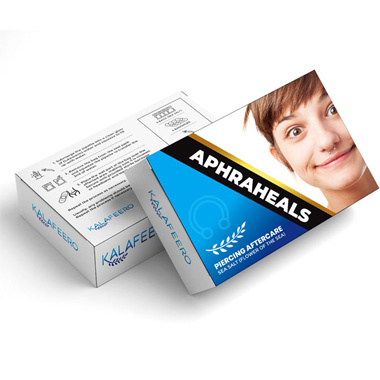Ear piercings have been part of human culture for thousands of years. From ancient rituals to modern fashion statements, they’ve always been a way to express identity and style.
The oldest evidence? A 5,300-year-old mummy named Ötzi the Iceman. He had stretched ear piercings measuring 11 mm!
A Short History of Ear Piercings
-
Protection & Tradition – In some cultures, pierced ears were believed to protect against evil spirits.
-
Eastern Medicine – The ear contains acupuncture points, so piercings were thought to have therapeutic benefits.
-
Sailors’ Belief – In the Middle Ages, sailors wore earrings hoping the value of the jewelry would pay for their burial if they washed ashore.
-
Fashion Trends – Between the 4th and 16th centuries, ear piercings lost popularity in Europe due to hairstyles covering the ears. They came back into fashion until clip-on earrings took over in WWI.
Why Ear Piercings Are So Popular Today
From simple lobe piercings to intricate cartilage piercings, the possibilities are endless. Both the softer (earlobe) and harder (cartilage) parts of the ear are suitable for piercings.
Whether you want one subtle stud or a full ear stack, there’s a style for everyone. But remember – each piercing has its own healing time and aftercare, so do your research before choosing.
Popular Ear Piercing Styles
1. Helix Piercing
Placed along the upper cartilage of the ear. Usually not painful and works with rings, barbells, or studs.
2. Forward Helix Piercing
Similar to the helix but lower, near the root of the ear. Often styled with elegant studs.
3. Industrial Piercing
Two piercings connected by a straight barbell – one in the forward helix, the other on the opposite upper ear.
4. Snug Piercing
A shallow piercing in the inner cartilage rim. Works best with micro jewelry.
5. Rook Piercing
Located above the tragus in the cartilage ridge. Looks great with curved barbells or rings.
6. Conch Piercing
Inner or outer cartilage, often styled with a statement ring. Named after the conch shell.
7. Orbital Piercing
Two holes connected by a single ring – popular in the helix or anti-helix area.
8. Tragus Piercing
The small flap in front of your ear canal. Works with multiple jewelry styles.
9. Anti-Tragus Piercing
Above the lobe, opposite the tragus.
10. Lobe Piercing
The classic! Heals quickly and is often the first piercing people get.
11. Transverse Lobe Piercing
A twist on the classic – a barbell placed horizontally through the lobe.
12. Daith Piercing
Through the innermost cartilage fold. Some say it may help with migraines.
13. Auricle Piercing
On the outer rim of the cartilage. Often paired with lobe piercings.
14. Dermal Piercing
Single-point surface piercing, sometimes placed just inside the tragus.
Helix Piercing
Helix piercings are cartilage piercings that are placed along the top ear. This piercing often does not hurt because there are no nerve endings in this part of the ear.
Although it is possible to wear studs, a lot of people choose to wear a captive bead ring or barbell.
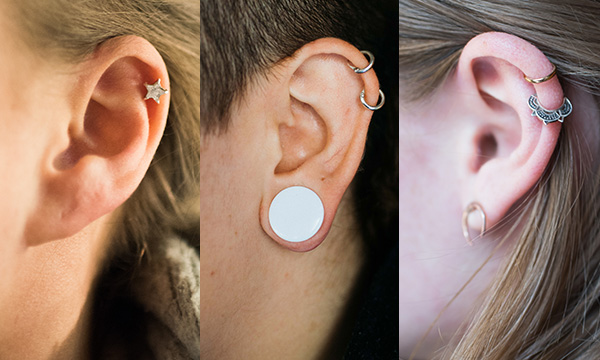
Forward Helix Piercing
The location for a Forward Helix piercing is similar to that of a regular helix piercing but slightly lower, near what is called the root of the helix.
Although there are many jewelry choices for the forward helix and it can even be incorporated into an industrial piercing, most people like to wear jewelry with studs.
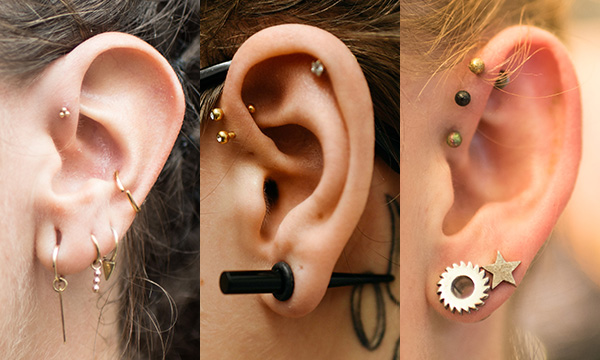
Industrial Piercing
Industrial piercings are actually a pair of piercings that are connected with a single piece of jewelry. With industrial piercings, one piercing is in the forward-helix area and the other is on the opposite side of the ear.
Generally, a single barbell is used to connect them, although a lot of various styles are used.
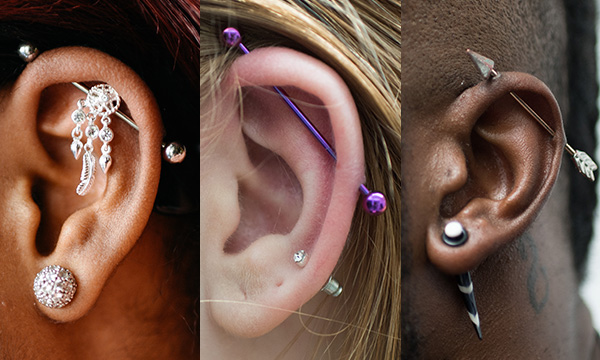
Snug Piercing
The snug piercing is one of the most distinctive ear piercings, as it's located in the inner cartilage area part-way down the ear's outer rim, just above the anti-tragus. It's a very shallow location, which is why you're likely to use micro jewelry when you get a snug piercing.
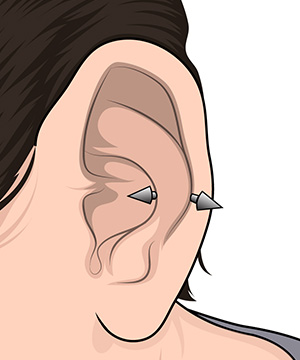
Rook Piercing
The rook piercing can be considered as sort of a cousin of the snug piercing. However, it's vertically oriented and found above the tragus on the ridge separating the inner and outer conch. This piercing looks really cool with either curved barbells or captive bead rings.

Conch Piercing
This cartilage piercing can either be of the inner or outer variety, though a lot of conch piercings cover both areas and use a captive bead ring for an eye-catching look. The name of the piercing comes from this part of the ear's resemblance to conch shells regularly found on ocean coasts.
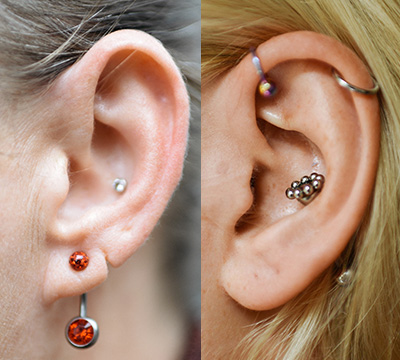
Orbital Piercing
Orbital piercings aren't exclusive to the ear, as they are technically any two piercings that are linked together with one piece of jewelry. Orbital piercings are particularly popular in the helix area or anti-helix.
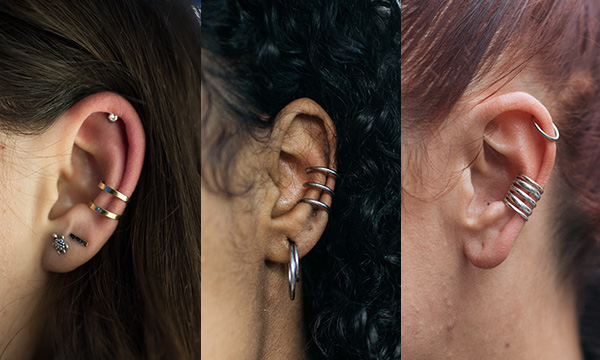
Tragus Piercing
The tragus is the part of your ear right in front of your ear canal. This piercing can be more or less difficult depending on the thickness and size of your tragus. However, it's also versatile and looks good with a number of jewelry styles.
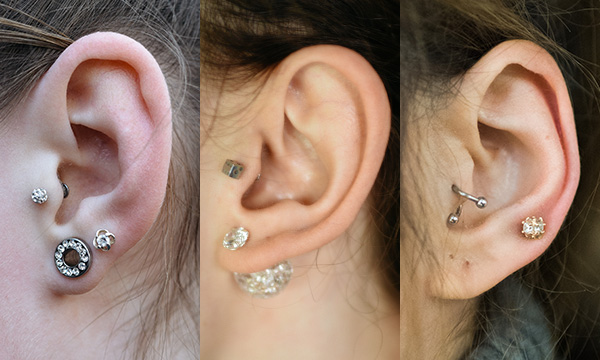
Anti-Tragus Piercing
Anti-tragus piercings are cartilage piercings located just above where traditional lobe piercings are done. Despite its name, the anti-tragus is actually really similar to tragus piercings in terms of characteristics and healing time.

Lobe Piercing
The lobe piercing is still perhaps the most common piercing throughout the world. It's quite possibly the first piercing you ever had done and also one of the quickest to heal. Many who love body modifications and piercings start with this one.

Transverse Lobe Piercing
Transverse lobe piercings are a new twist on an old classic. With transverse lobe piercings, a barbell is used to go horizontally through the earlobe instead of from the outside to the inside.
This one is highly subject to the shape and size of your earlobe, of course.
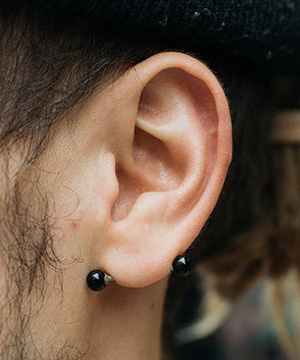
Daith Piercing
Daith piercings are performed through the innermost cartilage fold of the ear and can be difficult to access. For this reason, they should be done by a professional that you trust.
After the piercing is done, most opt for captive bead ring or curved barbell jewelry. One cool thing about this piercing is that it's often credited as a potential remedy for migraines.
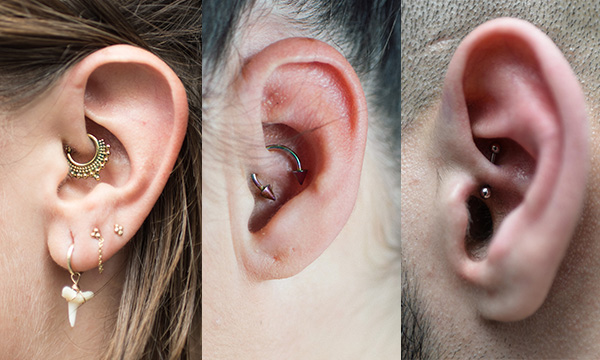
Auricle Piercing
Also known as rim piercings, auricle piercings are found on the rim of the cartilage near the outside of the ear. They are usually done in conjunction with one or more lobe piercings but can complement whatever piercings you already have with ease.
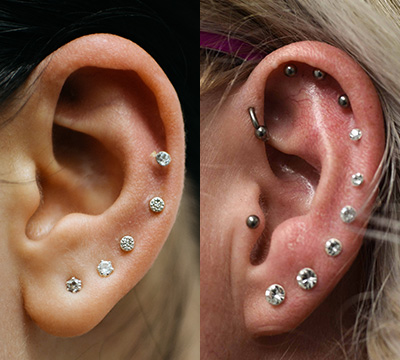
Dermal Piercing
Dermal piercings are a catch-all term for piercings that have just one visible point on the surface of the skin, but in terms of ear piercings, they can be located just inward from the tragus.
Choosing the Right Piercing
-
Consider your ear shape and lifestyle.
-
Think about healing time: cartilage piercings can take 4–9 months.
-
Follow aftercare instructions: clean with saline solution, avoid touching, and sleep carefully.
Ready to Get Pierced?
If you’re inspired to get a new piercing, book your appointment with us today.
Pick your perfect style
Choose a time that suits you
Pay online in advance – so you can relax during your appointment.
Book now at piercingzette.com and start your ear piercing journey!
Aphraheals - Piercing Aftercare



